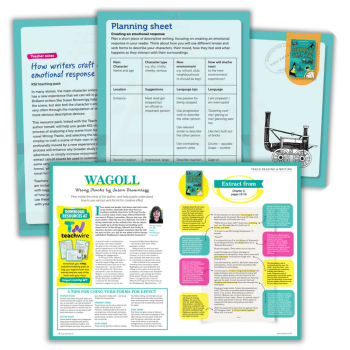Write a scene featuring lots of powerful verbs in which the narrator is profoundly moved by a new experience or environment by analysing a key scene from Susan Brownrigg’s gripping novel, Wrong Tracks.
In many stories, the main character enters a new environment or has a new experience that we can tell is going to be life-changing.
Brilliant writers like Susan Brownrigg help us to visualise the scene. However, they also help us feel the character’s emotional response to it. This is often through the manipulation of powerful verb forms as much as the more obvious descriptive devices.
This resource pack will enhance your study of the novel, or you can use it in isolation to teach some very useful authorial techniques.
Resources
This download contains:
- Extract from Wrong Tracks by Susan Brownrigg
- ‘How writers can craft an emotional response’ poster
- ‘Exploring writers’ techniques’ worksheet
- ‘Exploring writers’ techniques’ working wall display
- Potential new environment/experience images
- Planning sheet
Your class will work towards planning and writing their own scene in which the narrator has an emotional response to a new experience/environment.
Their challenge will be to move between different powerful verb forms to describe the scene and the action, as well as the character’s feelings.
Tips for using powerful verbs
Passive voice
Passive voice (when the usual object of a clause becomes the subject) can be useful. Used well, it can add atmosphere and tension to a scene. Passive sentences can also show when a character has lost power in a scene or can be used to hold back information in a mystery.
Active voice
Stories benefit hugely from protagonists being active and pushing the plot on. Using active sentences (subject, verb, object) will give your story more pace as your character is doing stuff – and doing things has consequences.
Present tense
Present tense has the story unfold for the reader at the same time as for the character. Combined with action verbs it can propel your story forward and keep a sense of tension. Some readers don’t like present tense narratives, as they find them less convincing.
Vivid verbs
There are lots and lots of powerful verbs to choose from when writing. The right one (as with strong nouns) will make your writing more vivid and precise. Using a thesaurus can help you find an alternative word that fits better.
Past tense
Past tense can give a sense of distance from events. How does the passage of time affect the pace of your story? Combined with first person, past tense can mute some of the drama, as we know the protagonist has survived to tell the tale. Past tense is often the default for novels.
What is Wrong Tracks about?
Wrong Tracks is a thrilling mystery-adventure set within the real events of the Rainhill Trials of 1829. Here, engineers competed to prove their locomotives would be the best for transportation on the new Liverpool and Manchester Railway.
History tells us that George Stephenson’s ‘Rocket’ was the winner. This novel introduces us to young Edward Entwistle (also the first-person narrator), employed by Stephenson to assist in the contest preparations.
Edward and Prudence, the serving girl at his lodgings, investigate a series of dangerous accidents that threaten to literally derail Stephenson’s attempt. They become increasingly suspicious that they aren’t accidents at all.
Thank you to Lindsay Pickton for creating the resource pack. Browse more WAGOLL packs from real authors.














